Everything there is to know about self-propelled lawnmowers

A lawnmower is a gardening tool that it used frequently throughout most of the year, except during winter. If you are thinking of changing your old push-type mower, why not consider upgrading to a self-propelled (powered) model? What are their advantages?
-
They move by themselves because the engine is connected to the wheels and transmits driving force to them.
-
You don't need to push them, just point them in the right direction.
-
They can also drive uphill and over rough terrain.
In practice, a self-propelled lawnmower is much more manageable than a push mower: it makes mowing less strenuous and time-consuming. What’s more, if cutting the grass isn’t one of your favourite pastimes, then a self-propelled lawnmower makes the task a lot easier. In short, there’s much to gain by investing a little more compared with a push-type model of similar power. Now, let's see how to choose your self-propelled lawnmower.
Criteria for selecting a self-propelled lawnmower: power supply, propulsion and deck
The first thing you want to evaluate when it comes to self-propelled lawnmowers is the power supply: is it better to go for a petrol engine, battery-powered or electric lawnmower? In general, petrol engine lawnmowers, including self-propelled versions, are more powerful. In addition, with a petrol lawnmower you have no constraints of any kind, in terms of distance from a power socket, length of the power cord, running time or battery charging times.
When comparing different types of self-propelled petrol engine lawnmower, consider the power output and engine displacement. The more powerful the machine, the better its performance. This means that you can work faster and tackle even the most demanding surfaces: spacious lawns covered with thick, tall grass, uphill slopes, uneven ground (or, in the most challenging cases, a mixture of all these).
Efco offers you an extensive choice of single-speed or 3-speed self-propelled petrol engine lawnmowers. With the LR 48 TK COMFORT PLUS you can mow lawns up to 1,800 m² in size, whereas the LR 53 TK ALLORAD PLUS 4 allows you to tackle areas of up to 2,000 m². With a professional self-propelled lawnmower you can mow up to 2,400 m² (AR 53 TBXE ALLROAD ALUMINIUM and AR 53 TK ALUMINIUM PRO) or 2,600 m² (MR 55 TBD).
From the heart of the lawnmower – its engine or motor – we move onto the body: the deck. To deal with the most demanding jobs, it’s better to choose a machine with a metal deck, which are more robust compared with a plastic deck. Efco self-propelled lawnmowers have a steel or aluminium chassis that are resistant to stones, uneven ground and collisions with kerbs and walls. For example, the LR 48 TK COMFORT PLUS and LR 53 TK ALLORAD PLUS 4 are made of steel, whereas the AR 53 TBXE ALLROAD ALUMINIUM, AR 53 TK ALUMINIUM PRO and MR 55 TBD models are made of aluminium.
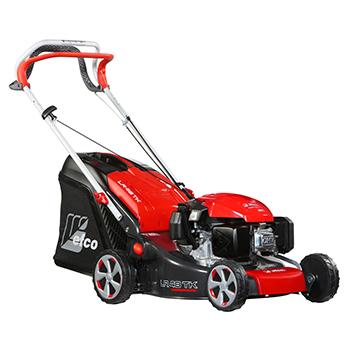
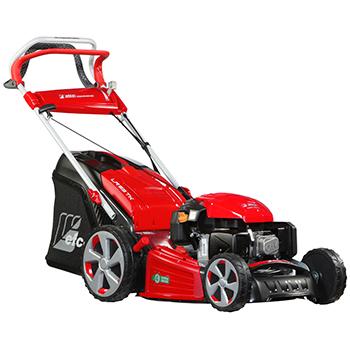
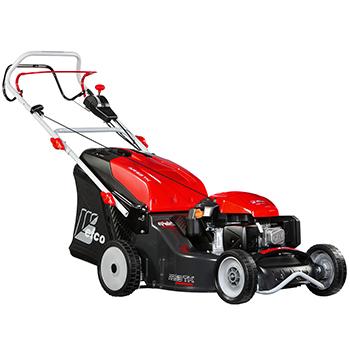
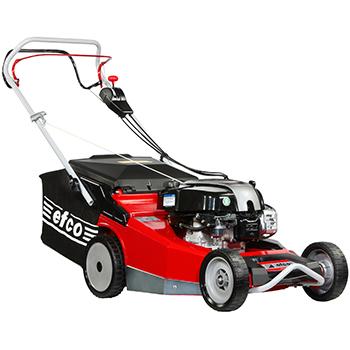
How to choose a self-propelled lawnmower: cutting characteristics and extras
Now let's focus on the cutting characteristics of self-propelled lawnmowers, specifically:
-
Cutting width
-
Cutting height
-
Cutting features
There cutting width depends on the blade length: the longer the blade, the faster you work because you can cover the same surface in fewer passes. As for cutting width, the models we mentioned vary from 46 cm for the LR 48 TK COMFORT PLUS to 53 cm for the MR 55 TBD.
The cutting height should be adjustable, so that you can easily adapt it to the characteristics of the grass and to seasonal changes. All the self-propelled Efco models that we referred to have a centralised cutting height adjustment system. So, you don’t need to set the height of each wheel, because a single control lets you set the desired lawn height to between 2 cm and 7.5 cm.
Once you’ve cut the grass, what are you going to do with it? You can dispose of it in your green waste bin, compost it to make organic matter for your garden and vegetable patch, use it as mulch or scatter it directly on the lawn as fertiliser. For these different cases you need different cutting features:
-
Rear discharge with extra-large grass catcher from 70 to 80 l for Efco self-propelled lawnmowers.
-
Side discharge: together with rear discharge equipped with deflector, which allows you to eject clippings to the side as you mow.
-
Mulching cutting system: cuts grass into tiny particles and distributes them evenly on the lawn, where they decompose quickly so you don’t need to rake them up.
In Efco models you get mulch cutting as standard (LR 53 TK ALLORAD PLUS 4, AR 53 TBXE ALLROAD ALUMINIUM and AR 53 TK ALUMINIUM PRO) or as an option (LR 48 TK COMFORT PLUS and MR 55 TBD). In this respect, the LR 53 TK ALLORAD PLUS 4 is a complete machine that offers all 4 possible cutting functions: rear discharge with deflector, collection with 70 l grass catcher, standard side discharge, and mulching.
What other aspects is it useful to keep in mind when choosing a self-propelled petrol engine lawnmower? Definitely the availability of an easy starting system, such as the InstartIS battery-powered electric starter on the AR 53 TBXE ALLROAD ALUMINIUM, or ReadyStart for the MR 55 TBD, which automatically detects the engine temperature and supplies the right amount of petrol, without you having to use the primer and regulate the air with the choke.
Also consider the wheels: they should be large – i.e. suitable for moving around easily on the most rugged terrain – and robust, perhaps made of aluminium like those on the AR 53 TK ALUMINIUM PRO and MR 55 TBD models.
Finally, another handy feature is a full bag indicator, which you will find on the LR 48 TK COMFORT PLUS, LR 53 TK ALLORAD PLUS 4, AR 53 TBXE ALLROAD ALUMINIUM and AR 53 TK ALUMINIUM PRO models. It solves the problems of unnecessary stops to check the grass catcher, and clippings falling out when it gets overloaded: with one look you can instantly find out when it's time to stop and empty the bag.
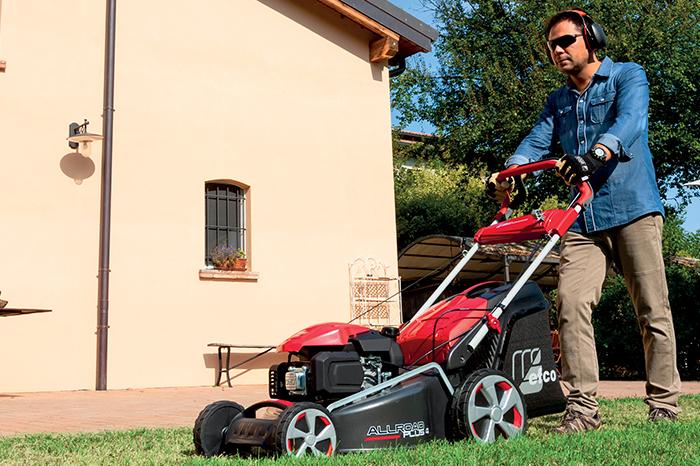
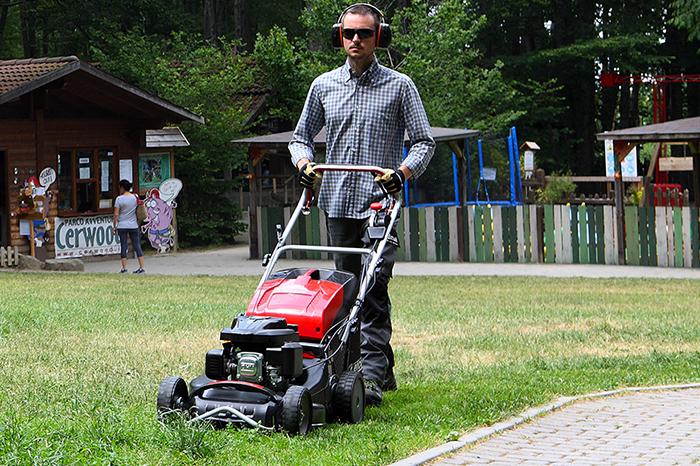
Maintaining a self-propelled petrol engine lawnmower
Let’s finish up with an essential checklist of maintenance tasks to keep your petrol engine lawnmower in top condition:
-
Clean the lawnmower deck.
-
Clean the enclosure air vents.
-
Check that all nuts and bolts are tight.
-
Clean the cutting deck and blade.
-
Check the condition and sharpness of the blade.
-
Check the condition of the mulching kit components.
-
Check the grass collector and rear discharge deflector.
-
Clean/change the air filter.
-
Clean the spark plug, check the distance between the electrodes and change the spark plug if necessary.
-
Clean the fins on the engine cylinder.
When servicing a petrol engine lawnmower, make sure that the engine is cold and the spark plug cap is disconnected. When handling the blade, always use utility or cut-resistant gloves.
So which is better — a self-propelled lawnmower or push mower? If you still have any doubts, you can read this overview of everything you need to know before buying a lawnmower.



